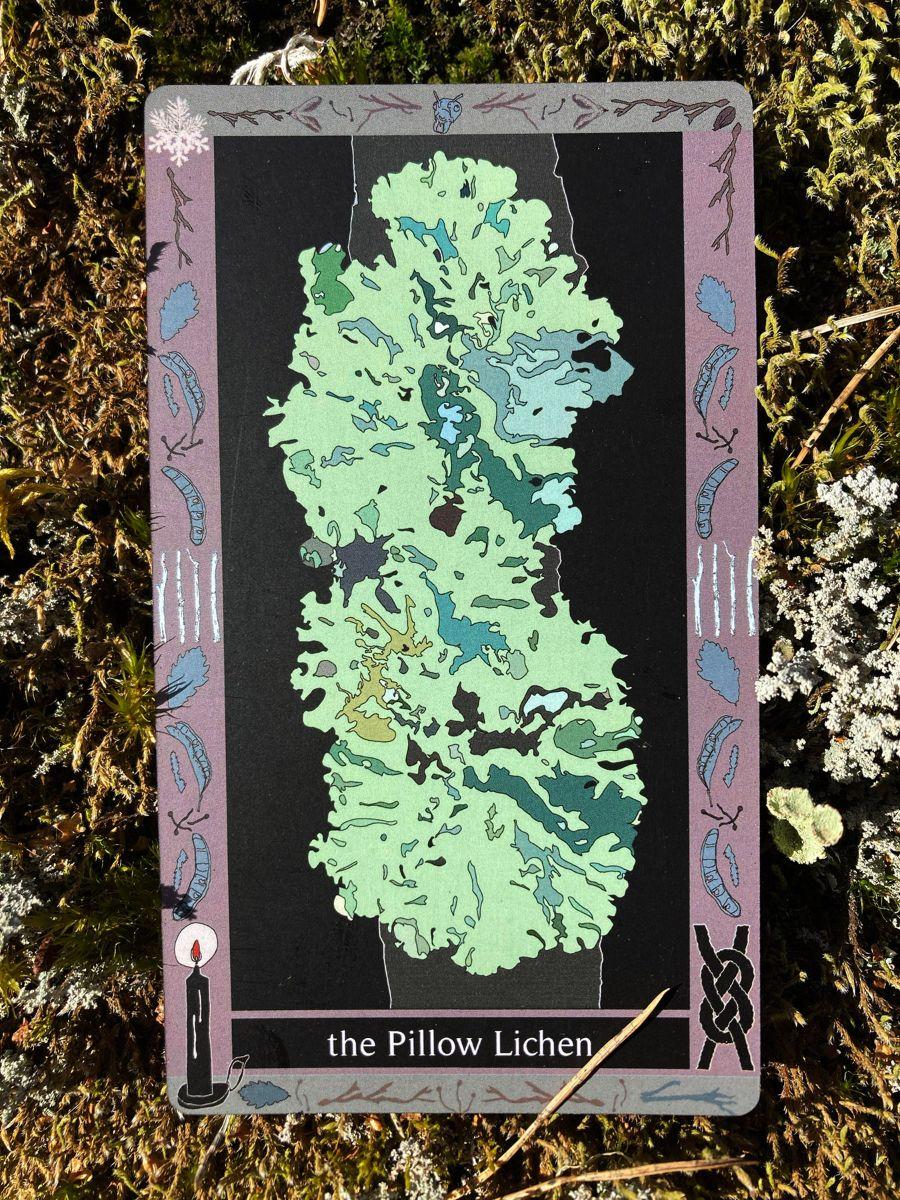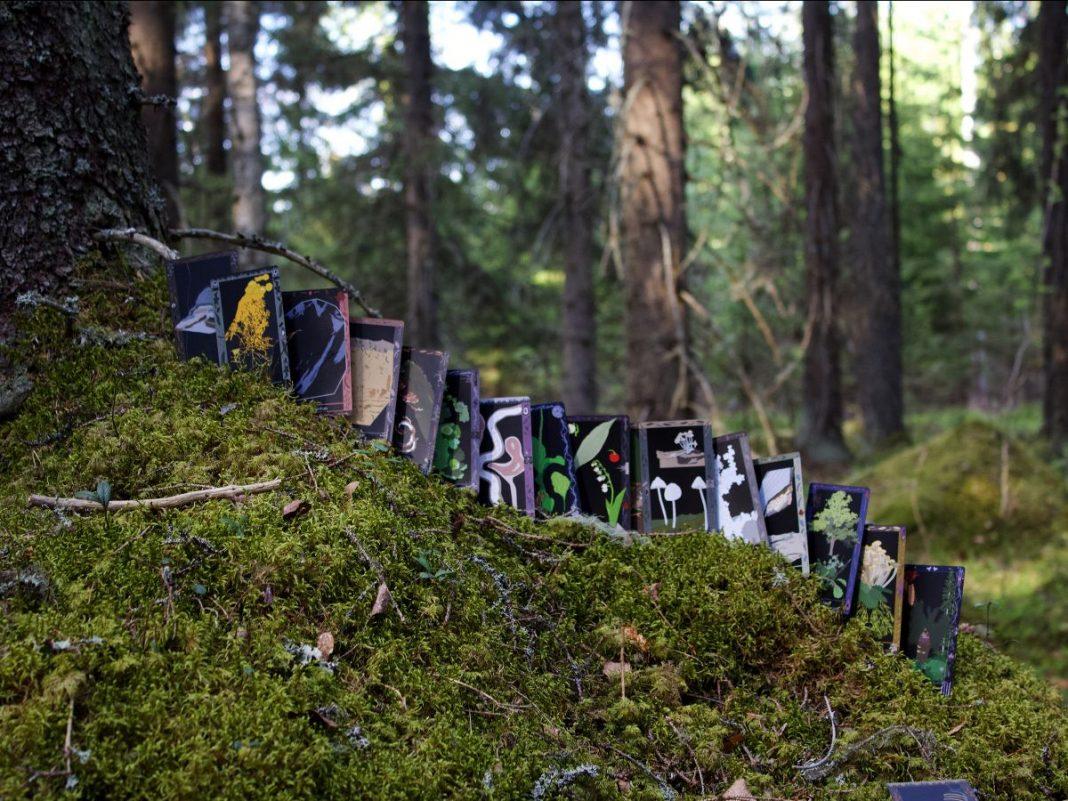We wanted to tell you about Glowwood, a brand-new oracle card deck and companion book rooted in ecology created by Ukrainian-American artist and writer Lisa Biletska. Five years in the making, Glowwood is truly the consequence of a deep and studied passion for the natural world. As Lisa writes in the Glowwood Companion’s introductory letter: For so long, the woods have been a source of knowledge, inspiration, and companionship for me. I have always tried to reciprocate by paying attention and paying tribute. This is how Glowwood came to be—through attention.
Glowwood’s 78 forest beings (plants, insects, fungi, lichens, and minerals) are here to draw us in, lift the veil of glowing design, and reveal the true magic of nature. Their world is non-hierarchical, non-humancentric, and profoundly real. The readable landscapes they form become reflections of our own selves: As we think about our desires, questions, and problems through the lifeways of the Glowwood creatures, their wild, interwebbed relationships enchant us to see our own world in renewed, reimagined ways.
Glowwood is nature’s language. The cards are the words. The spreads are the sentences.
— the Glowwood Companion
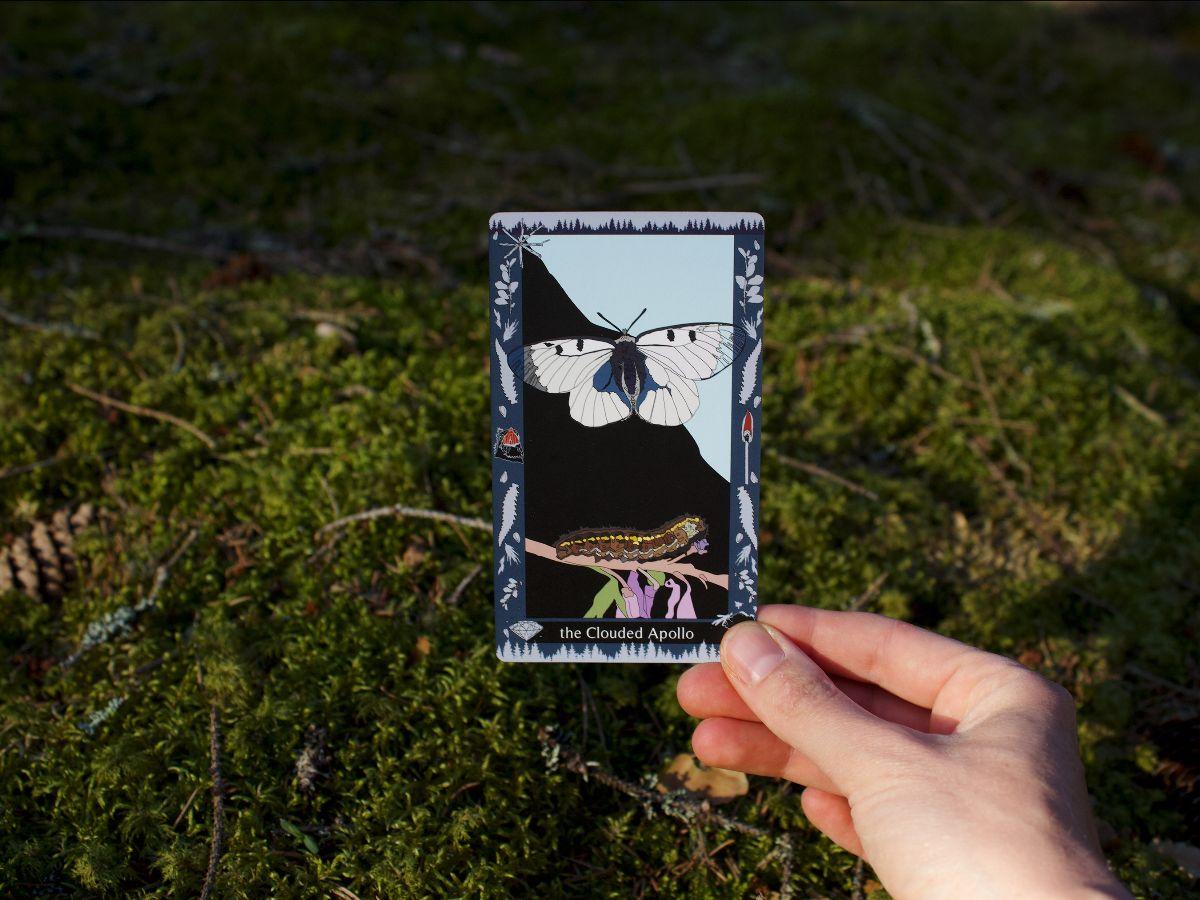
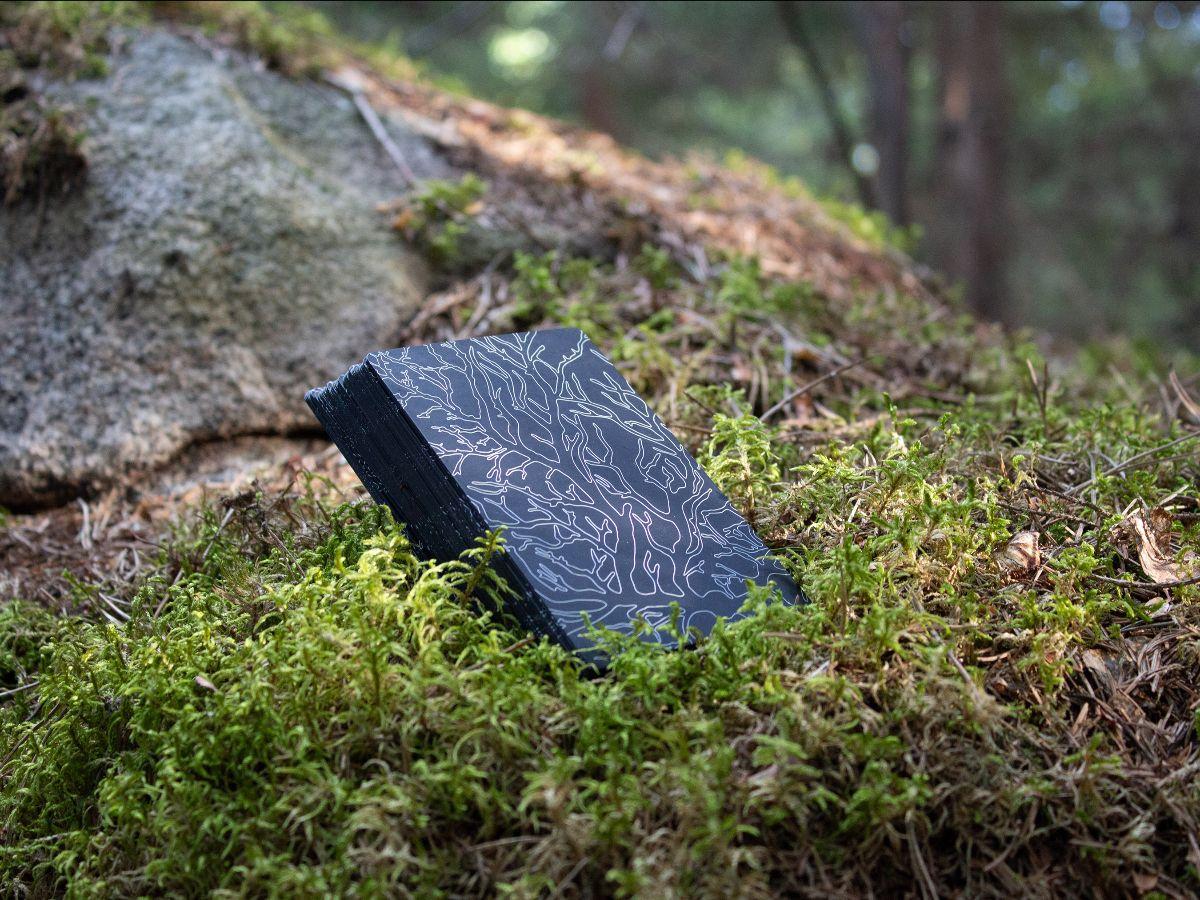
Lisa says that she doesn’t believe the Glowwood oracle card system is something she made up. She feels she has only received and passed on some of the messages we can all hear in nature. What makes the Glowwood cards so powerful is that they hinge on real ecological relationships and encode the world’s actual ways of being. It’s no wonder Glowwood is already attaining a small-yet-devoted cult following of readers who find that the cards and their poetry-in-prose paired texts hold profound insights for their own lives: By correlating the two systems—human lifeways and the lifeways of the woods—they can weave new, livable stories about themselves and the worlds they inhabit.
Lisa believes that this kind of inspired world-building, storytelling, and speculative projecting is at the root of all personal transformation and even world transformation, and is “most definitely something to live for.”
The box itself is a luxury affair: 78 thick, matte cards illustrated in a mysterious botanical style; a 276-page book of transcendental prose poetry and ecological tidbits that will help you delve into Glowwood’s richly layered content matter; and a heavy-duty drawstring bag to keep your cards safe during transport. All ship in a custom-designed sturdy box.
Intrigued? Read Lisa’s interview with her own deck below, or head over to glowwoodcards.com right away to find out why Glowwood is being called “the project of the decade” for yourself.
To stay in touch, be sure to follow Glowwood’s Instagram here and on Facebook at https://www.facebook.com/glowwoodoraclecards. You can also find more of Lisa’s work on her personal website.

A Deck Interview with the Glowwood Oracle (conducted by its creator, Lisa Biletska)
When I feel like I know something, such as my own deck, I like to check myself. Interviewing a deck is one way of getting to know it better. Decks form unique bonds with their owners, so I thought you might enjoy hearing about Glowwood’s bond with me. Thanks to James Himm Mitchell for sharing the spread below, which comes to us by way of Fire Raven and the Aeclectic Tarot community forum. Italicized passages are direct quotations from The Glowwood Companion, which ships with the deck.
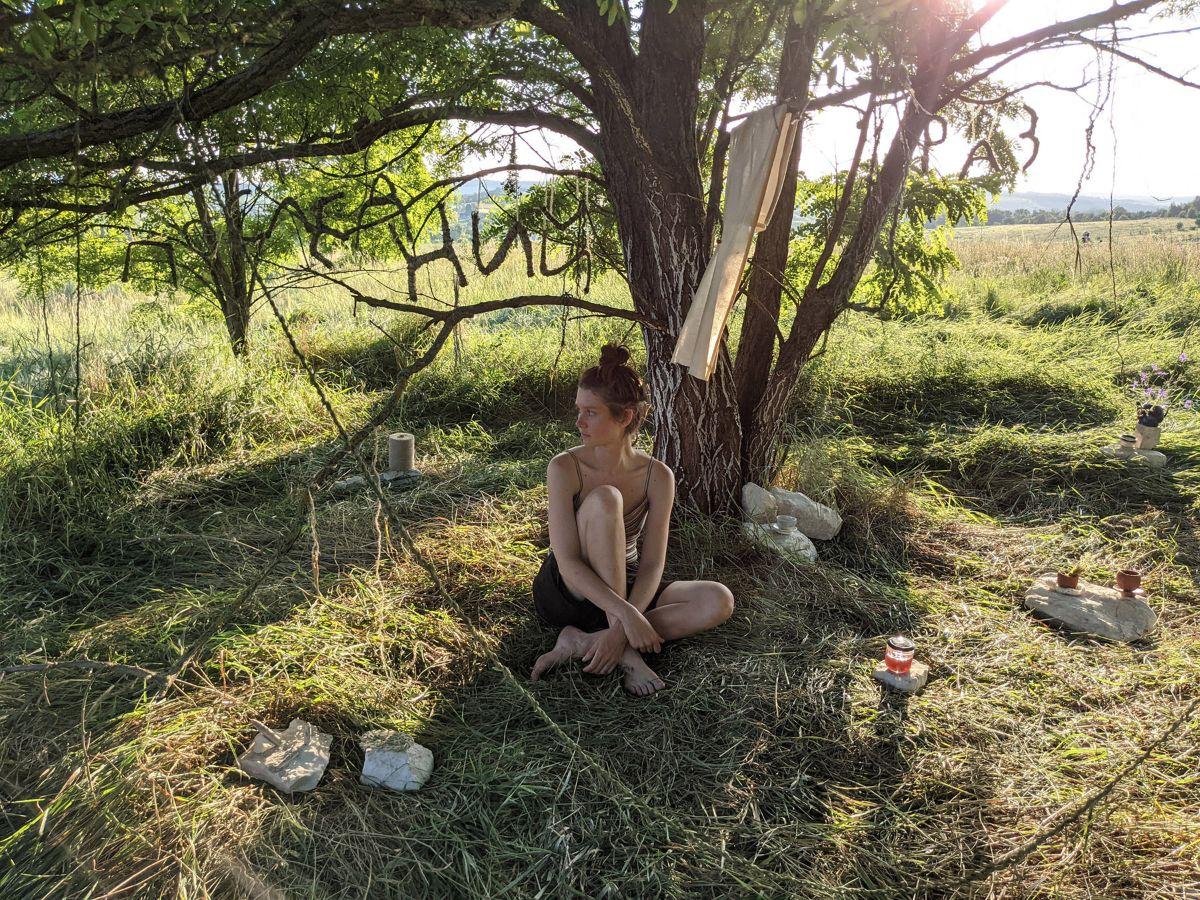
Tell me something about yourself: the Fall Webworm
I thought about Glowwood for years before I was actually able to sit down and create it start to finish. That period before the deck was filled with other projects, other dreams, “auxiliary engagements” like woodswalking, reading, foraging, a happenstance children’s summer camp—which eventually formed the structure from which the deck could stem. These external activities were Glowwood’s inheritance; they are the salt of it, the real longterm investment, and Glowwood is their expression. Of course, once I did have the luxury, protection, and personal space of giving Glowwood my undivided attention, it took about a year of reclusive moonlit silkspinning to give that expression a form. So does the Webworm lushly sheathe itself in silk and anything loose that can be found and used for warmth to envelop…the nascent promise. So much more I could say about this card regarding Glowwood’s beginnings, but I’ll stop here.
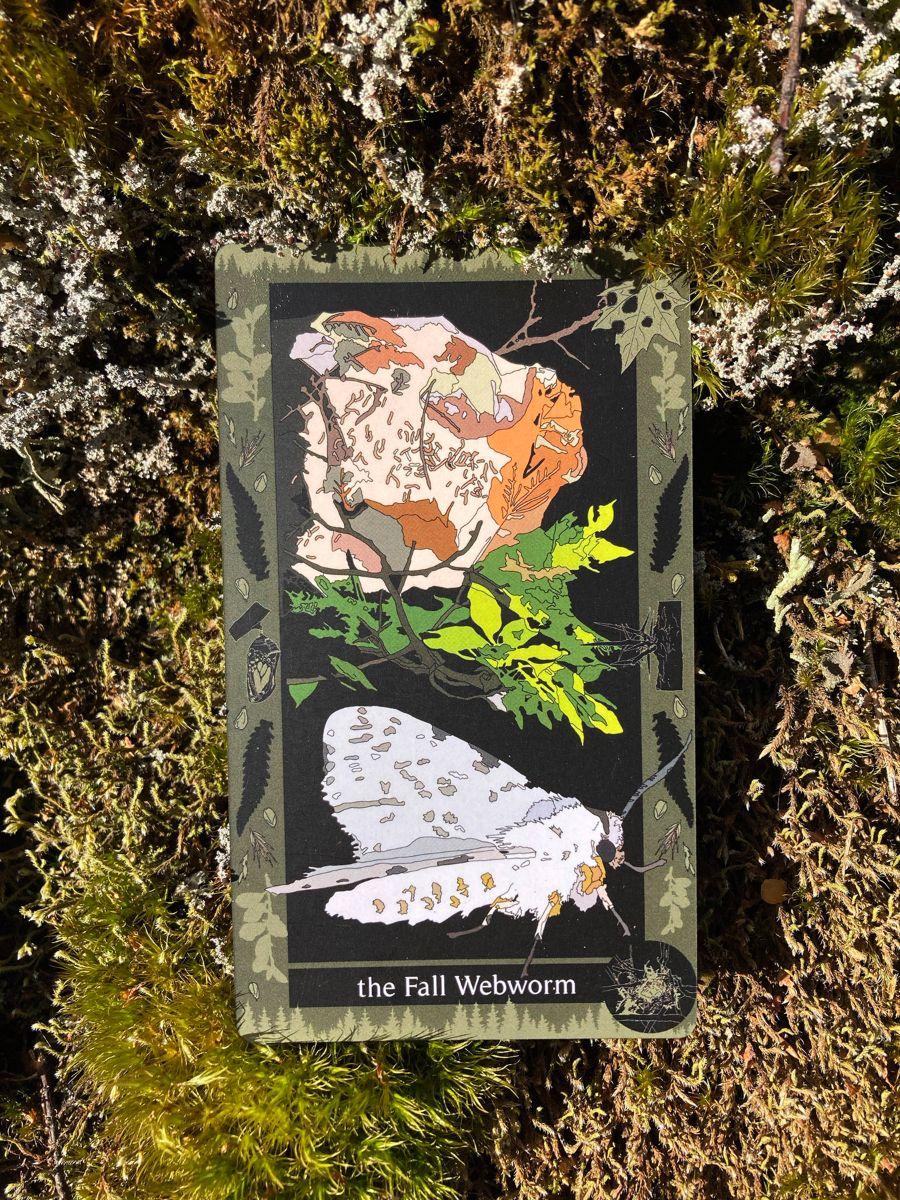
2. What are your strengths?: the Spider Mite
…a takedown by a thousand cuts. A transfer of power, sugar and sunlight slurped and usurped. Acknowledge the following change in energies: The longterm, the persistent, the immovable, the singular, and often the vulnerable, which wielded and wildcrafted the most rudimentary, elemental energies, is now passing into the invulnerable, the accelerated, the roaming, the crowd, the dispersed…
A bold statement from the Spider Mite and somewhat expected. Deep within Glowwood’s bedrock, running up and down its nervous system, is the ecological model: a non-hierarchical system where each being plays a unique role. It is also non-archetypal, so while no single “self” gets center stage, each lives a full, complex, idiosyncratic life, that is always intimately tied to the lifeways of others and to the system entire. Why does the Spider Mite sound so militant? Because the “old model”, as we all know by now, is also the model of heroes, human kings, avarice, and arrogance. It’s also the vulnerable model — kings are easily usurped. The webbed or rhizomatic structure (which is depicted on the card backs) distributes power across loci, setting off risk. Thinking together with this, through Glowwood, feels a bit like when your ears finally pop after flying or being underwater. A barely perceptible movement resulting in profound experiential effects.
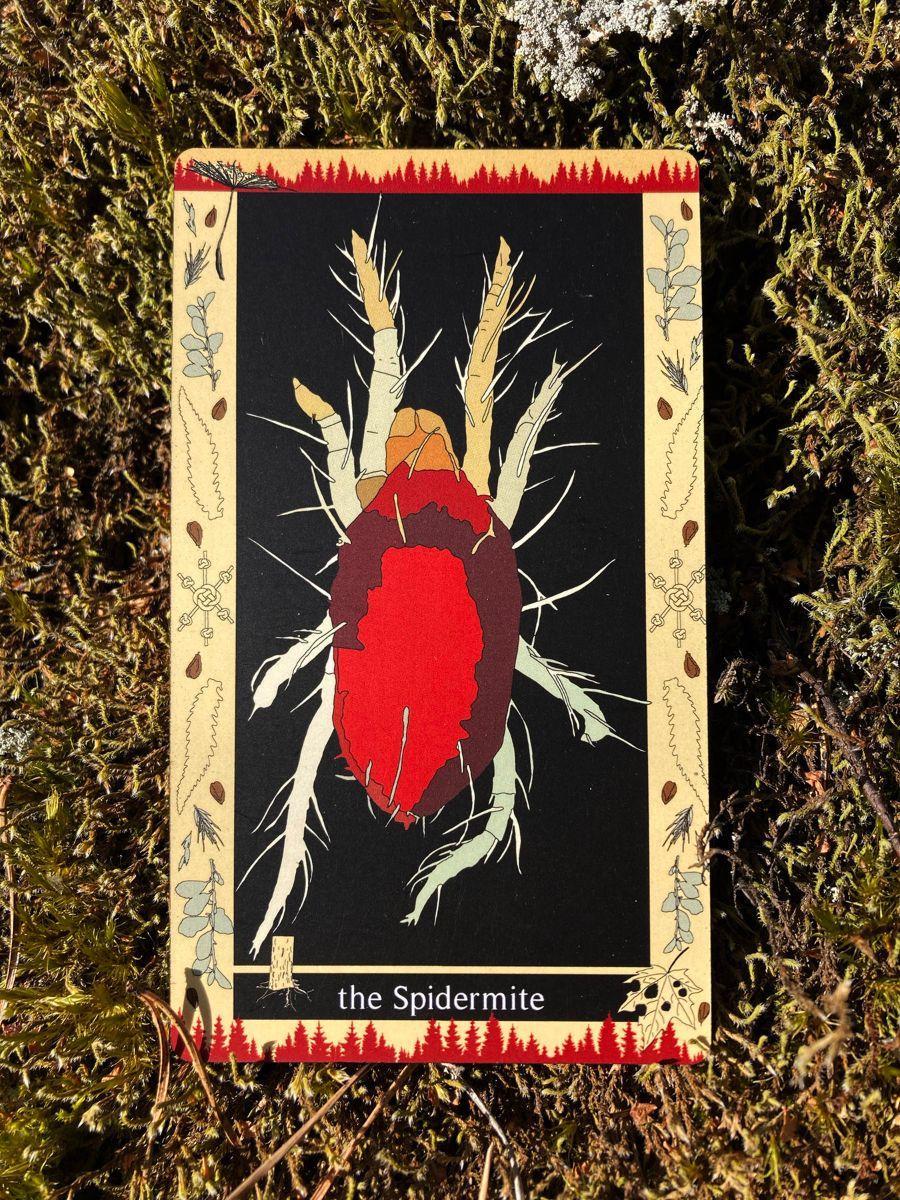
What are your (perceived) limitations?: the Milkweed
…Around this showy, attractive, and lofty presence, a dedicated inner circle has gathered. Some depend heavily on the Milkweed for support and protection. Some hope it might share methods that will help them successfully defend themselves against aggressors. And yet this is often what it cannot do for itself…It requires disruption to business as usual, leeway, preferential treatment, and does poorly when faced with initial competition, despite possessing numerous tactics to branch out into new areas. It is also easily bruised. However, when its spirit does take hold of a place, it can become tenacious and fierce…
I am reading this card regarding Glowwood’s presence in the world. Channeling human lives and preoccupations through Spider Mites and rock ecology can be fascinating, peculiar, and certainly niche. Glowwood’s approach is challenging. It demands a deep presence and involvement and rewards the seeker in kind. Naturally, the pool of people who dare to venture into Glowwood is smaller, but they do tend to really dig it.
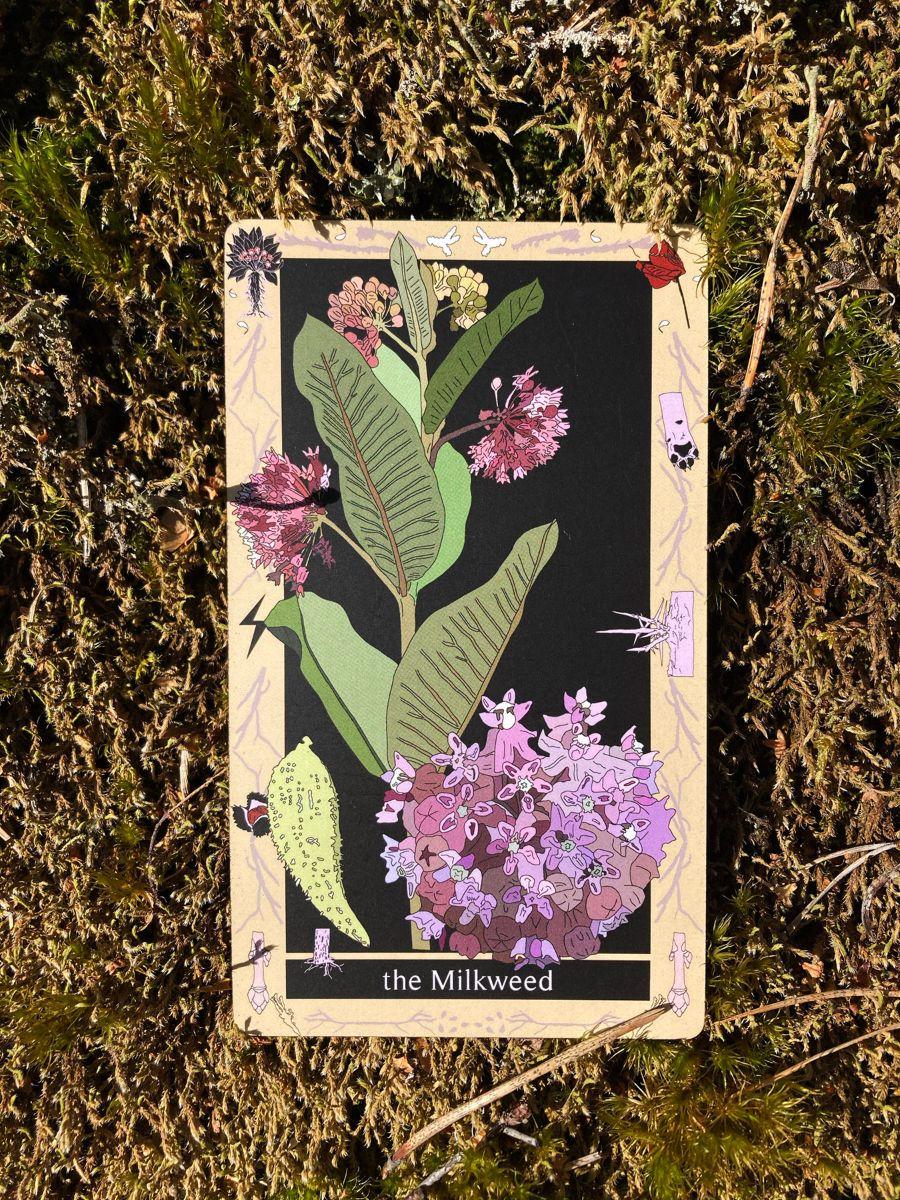
What are you here to teach me and/or What can I learn from you?: the Spider Wasp
Glowwood is, of course, a product not only of my love for the woods but also of my personal journey, one that has been terrific and terrifying by turns, certainly tortuous. The Spider Wasp has that take-charge attitude and strong approachthat focuses on movement in a landscape that may offer limited resources, where even water may be scarce. As a product of my history, Glowwood has resiliency stitched in as a golden thread. This is also an ecological lesson. Urging us towards practicality, resourcefulness, and composure.
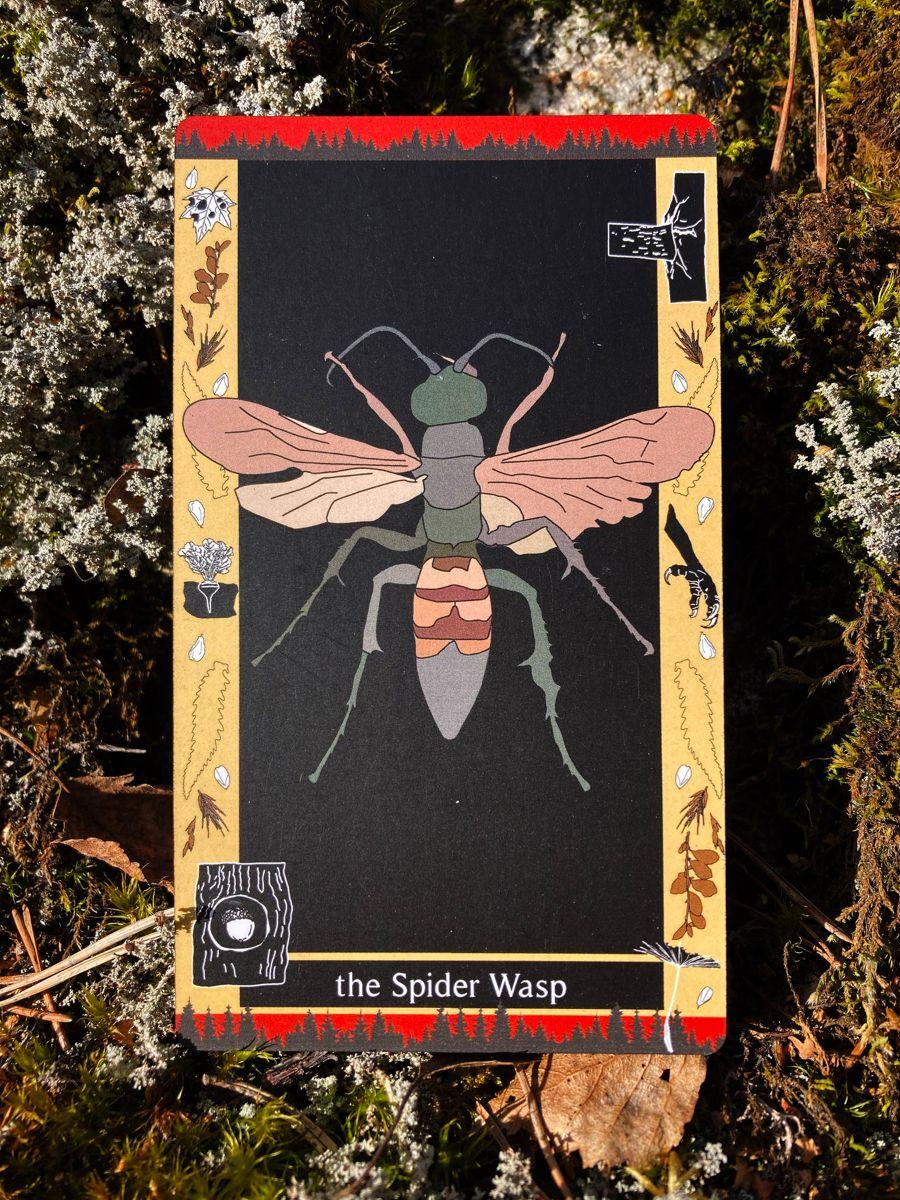
How do I best work with you and/or How would you like to be used?: the Death Cap
I’m glad this card came up, because it really illustrates what I mean when I say the deck is “not archetypal”, nor human-centric, nor is it based on mythology or stereotypes. We are looking at each being from its own perspective and the role it plays within its surroundings. The Death Cap is the most protective card of the deck. The keywords in the Companion have us contend with paradox: Glowwood, it seems, speaks to both atomic transformation and complete destruction, is a black box and yet possesses extreme potency, and despite these disquieting promises is very safe and secure. To those familiar with Hindu gods, I will say that this is Glowwood’s Kali energy — engaging with that “fullness of time” that comes from embracing the “changing aspect of nature”. People’s experience with the deck has been penetrating and unnerving: “uncanny” is a word I hear often. These kinds of portals must, I feel, always have a “do not disturb” sign on them, such is the nature of the quest. As Glowwood appropriately quips here, perhaps you should not ask the question or expect an answer.
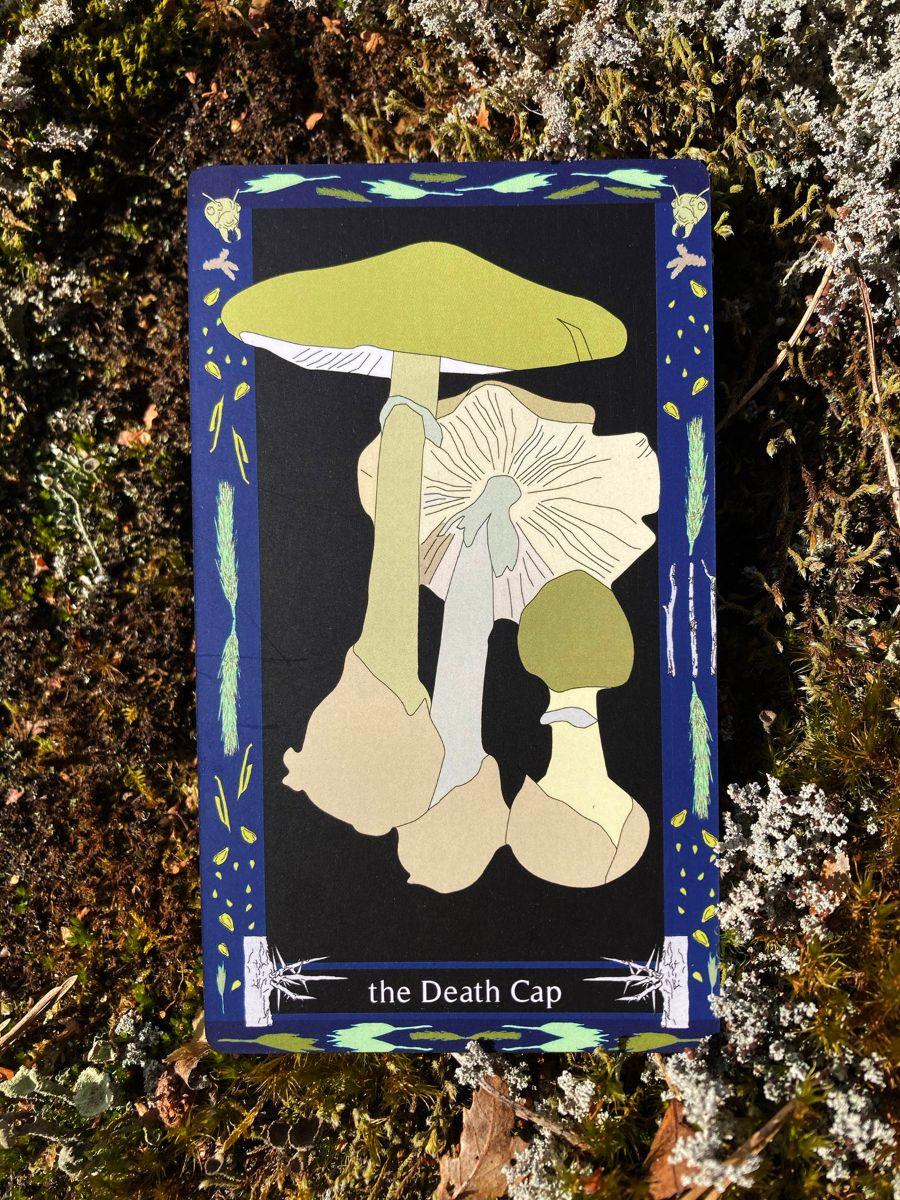
What will our relationship be like?: the Pillow Lichen
Maybe by now you too, dear reader, are sensing “the uncanny”. I do every time I read with this deck (Is it why I can’t read with it often? Too real, too much, too raw?) The Pillow Lichen is, like the other lichens in the deck, a card of partnership. This specific lichen indicates a unique habitat or engagement of great longevity and complexity. I could only hope for such a relationship with Glowwood — union, strong partnership, synergy, resourcefulness. Reassuring!
